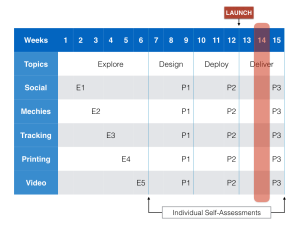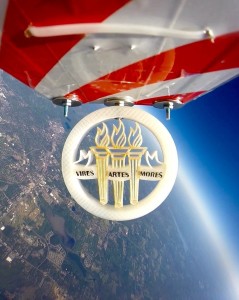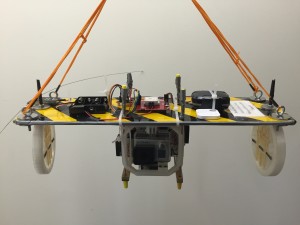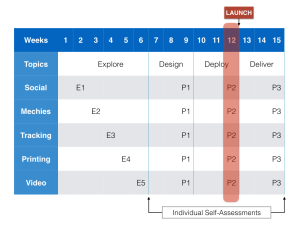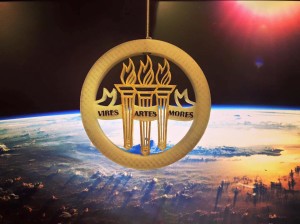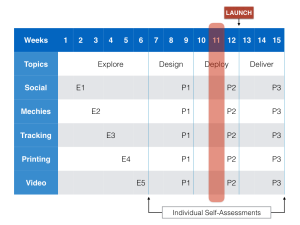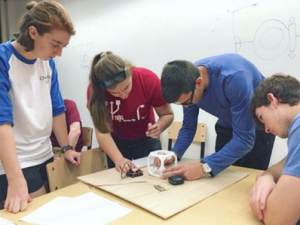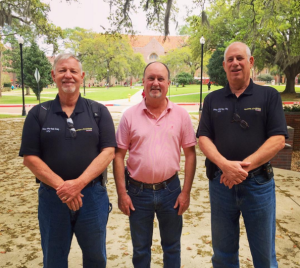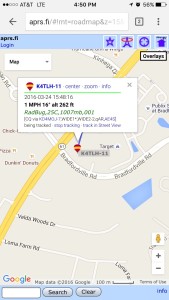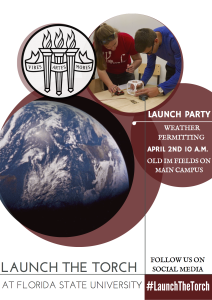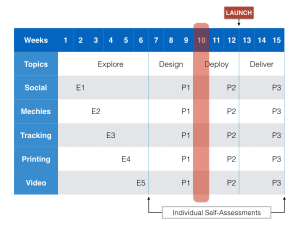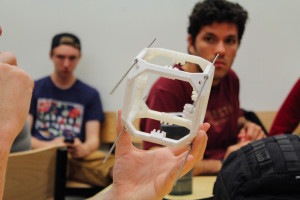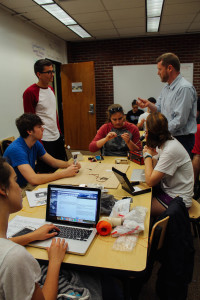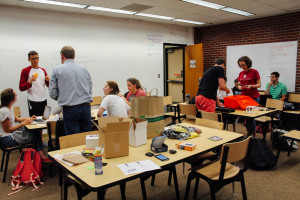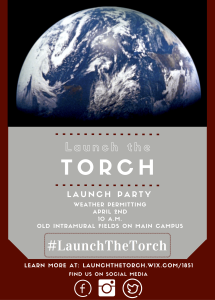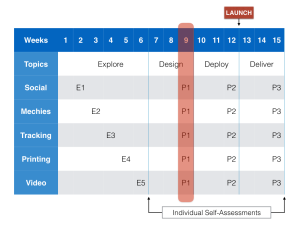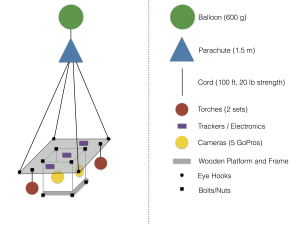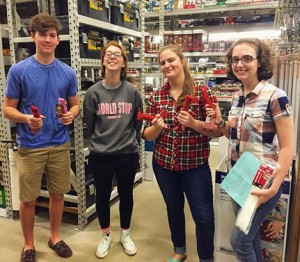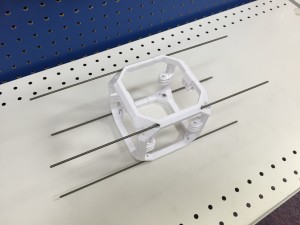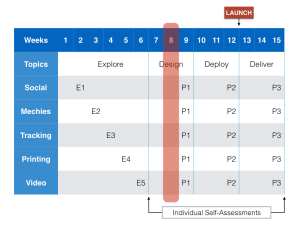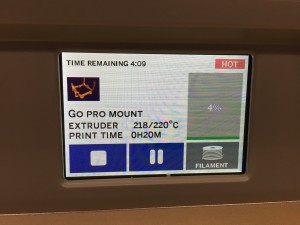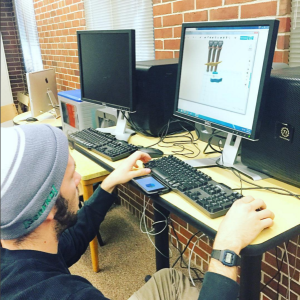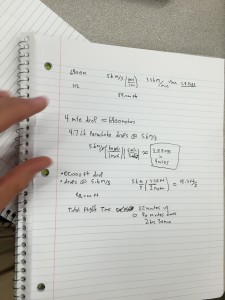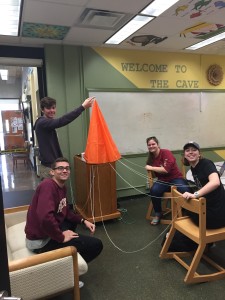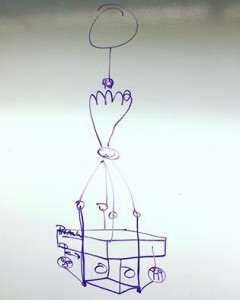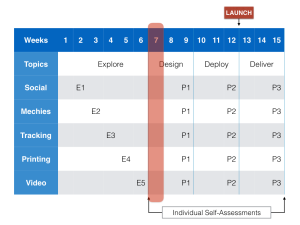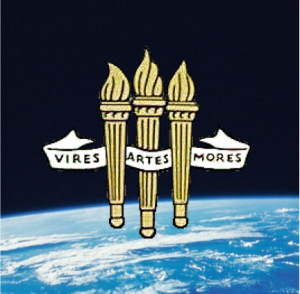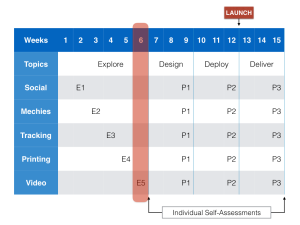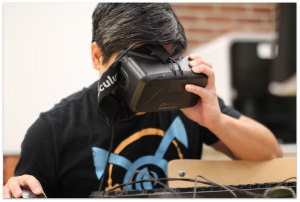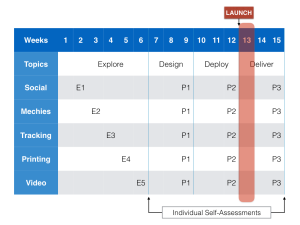 On Monday, April 4, 2016, at the start of Week 13 of the course, we launched our balloon from Florida State University’s intramural fields, which provided a suitable wide-open location devoid of trees or other obstacles that could snag our balloon or payload. We needed a day when the weather was perfect — no surface winds, not a cloud in the sky, and a relatively slow moving jet stream immediately overhead — and the day was perfect for our needs.
On Monday, April 4, 2016, at the start of Week 13 of the course, we launched our balloon from Florida State University’s intramural fields, which provided a suitable wide-open location devoid of trees or other obstacles that could snag our balloon or payload. We needed a day when the weather was perfect — no surface winds, not a cloud in the sky, and a relatively slow moving jet stream immediately overhead — and the day was perfect for our needs.
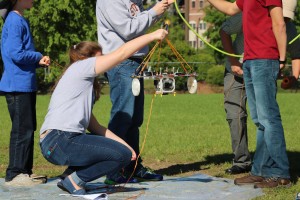 The launch itself went flawlessly, especially considering none of us had done this before (it also helped that had a dress rehearsal the day before, where we did everything except fill the balloon). Working from the ground up, we secured the cameras in the rig (all the GoPro batteries were fully charged and ready to record) but waited to turn them on until we were just about ready to launch (we were worried about how long the batteries would last in flight). Tightening the cameras mounts in the rig was a little tricky, as we didn’t want to snap the plastic, but we managed to secure all five cameras without incident (for good measure, we also secured the camera pointing down with a zip-tie).
The launch itself went flawlessly, especially considering none of us had done this before (it also helped that had a dress rehearsal the day before, where we did everything except fill the balloon). Working from the ground up, we secured the cameras in the rig (all the GoPro batteries were fully charged and ready to record) but waited to turn them on until we were just about ready to launch (we were worried about how long the batteries would last in flight). Tightening the cameras mounts in the rig was a little tricky, as we didn’t want to snap the plastic, but we managed to secure all five cameras without incident (for good measure, we also secured the camera pointing down with a zip-tie).
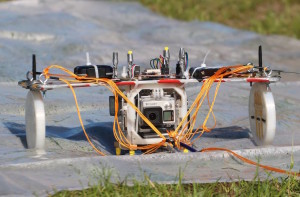 Once the cameras were ready to roll, we activated the SPOT Satellite Tracker, Eagle Flight Computer, and APRS Radio Transmitter, and confirmed that everything was working perfectly — special thanks to the Tallahassee Amateur Radio Society for setting up a digipeater close to campus so that we could track our payload from the Intramural Fields. We also made sure that everyone at the launch knew how to track both devices on their phones.
Once the cameras were ready to roll, we activated the SPOT Satellite Tracker, Eagle Flight Computer, and APRS Radio Transmitter, and confirmed that everything was working perfectly — special thanks to the Tallahassee Amateur Radio Society for setting up a digipeater close to campus so that we could track our payload from the Intramural Fields. We also made sure that everyone at the launch knew how to track both devices on their phones.
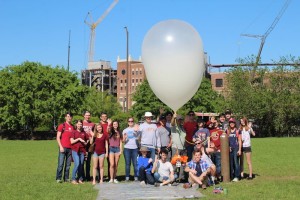 Once the payload was ready, we attached the parachute and began the process of inflating the weather balloon. To prevent any accidental loss of the balloon, we made sure that two extra safety lines were attached to the balloon at all times. Tracking the amount of positive lift as we inflated the balloon was a little tricky as the balloon swayed from side to side as we inflated it, but we used two different scales to find the most accurate measure. Once we had the right amount of helium in the balloon, we tied off the end, attaching the orange twine (leading to the parachute) to the balloon at this time.
Once the payload was ready, we attached the parachute and began the process of inflating the weather balloon. To prevent any accidental loss of the balloon, we made sure that two extra safety lines were attached to the balloon at all times. Tracking the amount of positive lift as we inflated the balloon was a little tricky as the balloon swayed from side to side as we inflated it, but we used two different scales to find the most accurate measure. Once we had the right amount of helium in the balloon, we tied off the end, attaching the orange twine (leading to the parachute) to the balloon at this time.
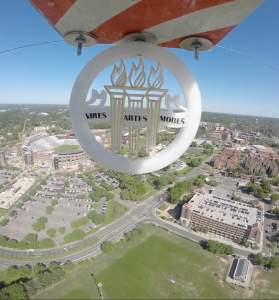 At this point, we were ready to launch. We turned the cameras on, disconnected the safety lines, and slowly raised the balloon, step-by-step. We didn’t want to jerk the twine or payload, so we let the balloon go up slowly, working our way down the twine from the balloon to the parachute, then down the parachute to the twine connecting the parachute to the payload (we had a carabiner at both ends of that twine — duct-taped shut for safety), and then down that twine to the carabiner hooked above the payload. At that point the balloon was about fifteen feet overhead, and ready to go. We confirmed that the payload was properly balanced under the parachute (with none of the twine caught up on anything), and let the balloon go — counting down from 3, 2, 1!
At this point, we were ready to launch. We turned the cameras on, disconnected the safety lines, and slowly raised the balloon, step-by-step. We didn’t want to jerk the twine or payload, so we let the balloon go up slowly, working our way down the twine from the balloon to the parachute, then down the parachute to the twine connecting the parachute to the payload (we had a carabiner at both ends of that twine — duct-taped shut for safety), and then down that twine to the carabiner hooked above the payload. At that point the balloon was about fifteen feet overhead, and ready to go. We confirmed that the payload was properly balanced under the parachute (with none of the twine caught up on anything), and let the balloon go — counting down from 3, 2, 1!
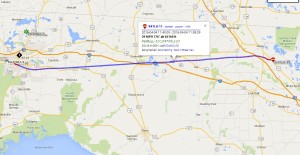 We then chased the balloon across North Florida, tracking our payload in real time on our phones. Using both the SPOT satellite tracker and the APRS radio transmitter (http://aprs.fi/) turned out to be a great idea as it gave us confidence that we knew exactly where the balloon was at all time. We constantly tweeted our payload location as we chased it, plus we were broadcasting publicly on K4TLH-11, so many people were tracking our flight at the same time!
We then chased the balloon across North Florida, tracking our payload in real time on our phones. Using both the SPOT satellite tracker and the APRS radio transmitter (http://aprs.fi/) turned out to be a great idea as it gave us confidence that we knew exactly where the balloon was at all time. We constantly tweeted our payload location as we chased it, plus we were broadcasting publicly on K4TLH-11, so many people were tracking our flight at the same time!
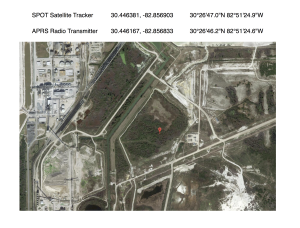 We were lucky that the winds were blowing almost exactly due east, so we were able drive almost straight out on I-10, following our balloon in real time. The balloon reached a height of 20333 meters before it popped over Madison, FL, at which point the parachute deployed, and the payload floated back to earth, landing (almost exactly two hours after we launched) in a Potash Mine in White Springs, FL. We are very grateful for the assistance provided by the employees of PotashCorp in locating our balloon, parachute, and payload, without whose help we could never have recovered our cameras.
We were lucky that the winds were blowing almost exactly due east, so we were able drive almost straight out on I-10, following our balloon in real time. The balloon reached a height of 20333 meters before it popped over Madison, FL, at which point the parachute deployed, and the payload floated back to earth, landing (almost exactly two hours after we launched) in a Potash Mine in White Springs, FL. We are very grateful for the assistance provided by the employees of PotashCorp in locating our balloon, parachute, and payload, without whose help we could never have recovered our cameras.
Having successfully recovered our payload, we then set to work creating a video about our project!
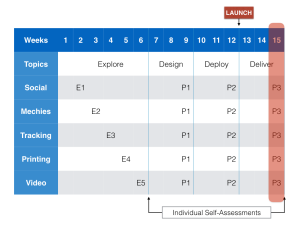 This was the last week of our class, and the final week of the “Deliver” phase of the course. We focused on finishing the class video about our activities all semester long. The students all selected their favorite still shots and video clips from the footage taken by our GoPro cameras during flight, plus we made sure to thank everyone who assisted us all semester long, making sure our project was a success!
This was the last week of our class, and the final week of the “Deliver” phase of the course. We focused on finishing the class video about our activities all semester long. The students all selected their favorite still shots and video clips from the footage taken by our GoPro cameras during flight, plus we made sure to thank everyone who assisted us all semester long, making sure our project was a success!